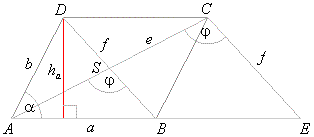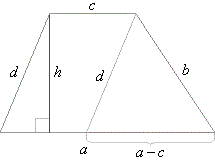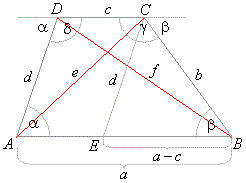|
| Applications
of Trigonometry |
|
|
 Applications
in Plane Geometry
Applications
in Plane Geometry |
 The parallelogram - Area of a
parallelogram
The parallelogram - Area of a
parallelogram |
 Trapezoid or trapezium
Trapezoid or trapezium |
|
The area of a trapezoid given its four sides
|
|
The area of the trapezoid given two parallel sides
(bases) and angles at the ends of the longer base |
|
Diagonals of a trapezoid,
determining the diagonals of the trapezoid given its four sides |
|
|
|
|
|
|
|
|
Applications
in Plane Geometry
|
|
The parallelogram - Area of a parallelogram
|
|
The parallelogram in the figure consists of two congruent triangles,
DABD and
DBCD,
therefore its area
|
 |
|
|
| Triangles,
BEC
and ABD,
are congruent as
are ABS
and DSC,
thus
the
area of the parallelogram equals the area of
the triangle AEC. |
|
 |
|
|
We use the formula for the area of a triangle given two adjacent sides and angle between them,
|
|
|
|
|
|
Trapezoid or trapezium
|
|
Trapezoid or trapezium is a quadrilateral with two parallel sides of unequal length which is determined by its
four parts.
|
|
-
The area of a trapezoid given its four sides
|
| The trapezoid in
the figure consists of a triangle and a parallelogram.
|
| According to Heron’s formula for the area of a triangle
|
 |
| The area of the parallelogram
AP
= c ·
h
where h
is the height of the triangle too. Therefore, the area of the triangle
|
|
 |
|

|
|
Thus, the area of the trapezoid given its four sides
|
 |
|

|
|
|
|
-
The area of the trapezoid given two parallel sides (bases),
a
and c, and the angles,
a and
b
at ends of
|
|
side a
|
|
|
| so, the area of the trapezoid |
 |
|
|
|
|
|
-
Diagonals of a trapezoid,
determining the diagonals of the trapezoid given its four sides
|
| In DABC,
using the cosine law e2
= a2 + b2 -
2abcosb, |
|
and in DACD,
e2
= c2 + d2 -
2cdcosd, |
| then
a2
+ b2 -
2abcosb
= c2 + d2 -
2cdcosd |
| and
since cosd
= cos(180°
-
a)
=
-
cosa |
| then
2cdcosa
+ 2abcosb
= a2 -
c2 + b2 -
d2
(1) |
|
Similarly, in DABD,
f2
= a2 + d2 -
2adcosa, |
|
and in DBCD,
f2
= b2 + c2 -
2bccosg, |
|
 |
|
|
thus, a2
+ d2 -
2adcosa
= b2 + c2 -
2bccosg
and since cosg
= cos(180°
-
b)
= -
cosb
|
|
then 2adcosa
+ 2bccosb
= a2 -
b2 + d2 -
c2
(2)
|
|
To separate the term containing cosa
from (1)
and (2), multiply
(1)
by c
and (2)
by a, then subtract first
equation from second thus, obtained is
|
|
2(a2
-
c2) · dcosa
= (a2
-
c2) · (a
-
c)
+ (d2
-
b2) · (a
+
c)
|

|
|
To separate the term containing cosb
from (1)
and (2), multiply
(1)
by a
and (2)
by
c, then subtract second
equation from first thus, obtained is
|
|
2(a2
-
c2) · bcosb
= (a2
-
c2) · (a
-
c) -
(d2
-
b2) · (a
+
c)
|

|
|
Derived expressions for e2 and
f 2
will be positive only if a
< b + c + d
and a -
c > b -
d. From the diagram in the above figure it follows that first condition must be satisfied, the trapezoid to be closed, and second condition must be satisfied, the triangle
EBC to be closed.
|
|
|
|
|
|
|
|
|
|
|
|
|
|
|
|
|
|
|
| Geometry
and use of trigonometry contents - B |
|
|
 |
|
| Copyright
© 2004 - 2020, Nabla Ltd. All rights reserved. |